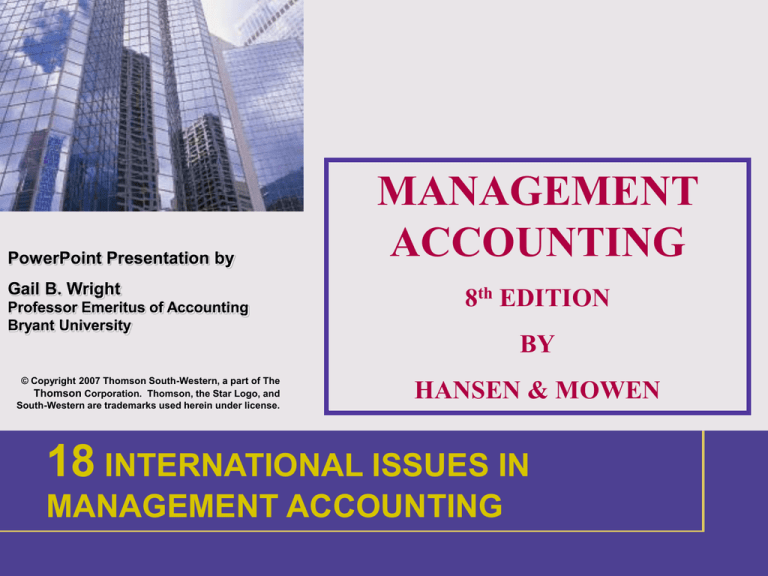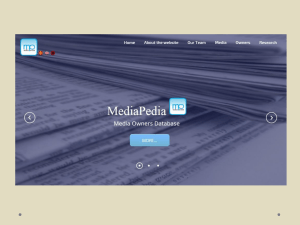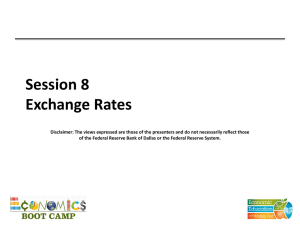learning objective
advertisement

PowerPoint Presentation by Gail B. Wright Professor Emeritus of Accounting Bryant University MANAGEMENT ACCOUNTING 8th EDITION BY © Copyright 2007 Thomson South-Western, a part of The Thomson Corporation. Thomson, the Star Logo, and South-Western are trademarks used herein under license. HANSEN & MOWEN 18 INTERNATIONAL ISSUES IN ACCOUNTING 1MANAGEMENT INTRODUCTION 1 LEARNING OBJECTIVES LEARNING GOALS After studying this chapter, you should be able to: 2 LEARNING OBJECTIVES 1. Explain the role of the management accountant in the international environment. 2. Identify the varying levels of involvement that firms can undertake in international trade. 3. List the ways management accountants can manage foreign currency risk. 4. Explain why multinational firms choose to decentralize. continued 3 LEARNING OBJECTIVES 5. Describe how environmental factors can affect performance evaluation in the multinational firm. 6. Discuss the role of transfer pricing in the multinational firm. 7. Discuss ethical issues that affect firms operating in the international environment. Click the button to skip Questions to Think About 4 QUESTIONS TO THINK ABOUT: Milbourne Shutter Company What are the business issues to consider in deciding whether to trade overseas? 5 QUESTIONS TO THINK ABOUT: Milbourne Shutter Company If exchange rates can either increase or decrease, are the risks equal? Would Jeff be more concerned about one or the other? Why or why not? 6 QUESTIONS TO THINK ABOUT: Milbourne Shutter Company When considering each international order on a case-bycase basis, what might influence his decisions? 7 QUESTIONS TO THINK ABOUT: Milbourne Shutter Company Are there differences in considerations for shipping internationally & shipping to another state? Or trade with France versus trade with Russia or Iran? 8 LEARNING OBJECTIVE 1 Explain the role of the management accountant in the international environment. 9 LO 1 MANAGEMENT ACCOUNTING In an international environment requires a shift in perspective. There are: Implications of foreign currency exchange Differences in credit practices Differences in cultural, legal, political, and economic environments 10 LEARNING OBJECTIVE 2 Identify the varying levels of involvement that firms can undertake in international trade. 11 LO 2 MULTINATIONAL CORPORATION (MNC) MNC “does business in more than one country in such a volume that its well-being & growth rest in more than one country.”1 1Hansen & Mowen, 2007, p. 808. 12 LO 2 INTERNATIONAL TRADE Levels of involvement Importing & exporting Concern: Tariffs & foreign trade zones Treaties Wholly owned subsidiaries Joint ventures 13 LO 2 TARRIFF: Definition Is a tax on imported or exported goods. 14 LO 2 FOREIGN TRADE ZONES Are set up by government in US near ports of entry but considered outside US commerce. Goods imported into foreign trade zones are duty free Company can postpone payments of duty No duty on defective materials Imported goods can be modified to meet US regulations High tariff components can be assembled into lower-tariff finished products 15 LO 2 ROADRUNNER VS. WILYCOYOTE.: Background Roadrunner operates a petrochemical plant that imports volatile materials in a foreign trade zone while a rival, Wilycoyote, operates a similar plant just outside the foreign trade zone. The two companies pay duty on imports differently. 16 LO 2 DUTY ANALYSIS Duty paid at purchase Carrying costs of duty Duty paid at sale Total duty, duty-related costs Roadrunner Wilycoyote $ 0 $ 24,000 0 1,920 16,800 0 $ 16,800 $ 25,920 Duty paid on sale by Roadrunner is significantly lower than duties paid by Wilycoyote on import. 17 LO 2 TARIFFS & TREATIES Can be managed by treaties among countries. NAFTA allows reduced tariffs on goods imported among Canada, US, and Mexico. 18 LO 2 WHOLLY OWNED SUBSIDIARIES Can be purchased companies or companies set up as subsidiaries or branch offices in foreign companies. 19 LO 2 OUTSOURCING: Definition Is payment by a company for business functions formerly done in-house. 20 LO 2 JOINT VENTURE: Definition Is a type of partnership in which investors co-own the enterprise. A special example is a maquiladora, a manufacturing plant in Mexico. 21 LEARNING OBJECTIVE 3 List the ways management accountants can manage foreign currency risk. 22 LO 3 FOREIGN CURRENCY RISK: Definition Refers to the company’s management of its transaction, economic, & translation risks due to exchange rate fluctuations. 23 LO 3 MANAGING CURRENCY RISK Transaction risk Possibility that future cash transactions will be affected by exchange rate fluctuations Economic risk Possibility that a firm’s present value of future cash flows will be affected by exchange rate fluctuations Translation (accounting) risk Degree to which firm’s financial statements are exposed to exchange rate fluctuations 24 LO 3 SPOT RATES EXHIBIT 18-1 Exchange rate on spot market for US dollars. 25 LO 3 MANAGING TRANSACTION RISK Companies face risk of currency appreciation (depreciation). They can manage the effects of fluctuating exchange rates on cash transactions by using Spot (immediate) rate Hedging Forward exchange contract for specified amount at specified rate on specified future date. 26 LO 3 TRANSACTION GAINS, LOSSES: Background SuperTubs, Inc. sells whirlpool tubs at home and in foreign markets. SuperTubs sold 100 tubs on 1/15 for $1,000 each to be paid 3/15. The exchange rate on 1/15 is .82 euros per $1. What is the gain/loss on 3/15 if the exchange rate is .84 euros on 3/15? If the exchange rate is .80 euros? 27 LO 3 EXCHANGE RATE LOSS Receivable in dollars 1/15 Receivable in dollars 3/15 Exchange loss $ 100,000 97,619 $ 2,381 The exchange rate rose from .82 euros to .84 euros per $1, providing an exchange loss. 28 LO 3 EXCHANGE RATE GAIN Receivable in dollars 1/15 Receivable in dollars 3/15 Exchange gain $ 100,000 102,500 $ 2,500 The exchange rate dropped from .82 euros to .80 euros per $1, providing an exchange gain. 29 LO 3 HEDGING CURRENCY FLUCTUATIONS: Background SuperTubs, Inc. engages in hedging to offset a possible loss on exchange rate fluctuations. On 1/15, SuperTubs purchased a contract to exchange 82,000 euros into dollars at a forward rate of .825 euros. On 3/15, SuperTubs pays 82,000 euros to the dealer and receives $99,394. 30 LO 3 HEDGING Receivable in dollars 1/15 Receivable in dollars 3/15 Premium expense $ 100,000 99,394 $ 606 The cost of hedging against currency fluctuations is less than the loss from doing nothing. 31 LO 3 MANAGING ECONOMIC RISK Companies must manage risk to the present value of future cash flows due to exchange rate fluctuations. The management accountant must: Understand the company’s position in a global economy Provide financial structure and communication for the firm Encourage use of hedging 32 LO 3 MANAGING TRANSLATION RISK Companies must manage risk presented when the effects of financial transactions are not the same in different currencies. Multinational, Inc., has a foreign division (FD) with eroding sales. Management directs FD to increase marketing expenditures, which FD does by increasing the expenditures by 10% per quarter. continued 33 LO 3 MARKETING EXPENDITURES Quarter 1 2 Expenditures in Local Currency LC 10,000 LC 11,000 3 LC 12,100 4 LC 13,310 Expenditures in local currency were increased by 10% per quarter over the year. 34 LO 3 MARKETING EXPENDITURES Quarter 1 2 Expenditures in Dollars $ 10,000 9,167 3 8,963 4 8,873 Expenditures in dollars were decreasing each quarter over the year, a fact hidden in currency translation. 35 LEARNING OBJECTIVE 4 Explain why multinational firms choose to decentralize. 36 LO 4 ADVANTAGES OF DECENTRALIZATION Local level information is higher quality Local managers can make a more timely response in decision making Less likely to misinterpret instructions at local level due to language differences 37 LO 4 How do MNCs address language differences? MNCs 1) push decision making down to local manager, and 2) incorporate technology that overrides language barriers. 38 LO 4 How do MNCs address decentralization? MNCs create different divisions by 1) geographic lines, 2) product lines, and 3) functional management lines. 39 LEARNING OBJECTIVE 5 Describe how environmental factors can affect performance evaluation in the multinational firm. 40 LO 5 EVALUATING PERFORMANCE Managers should be evaluated only on those factors that the manager has control over. Evaluations based on revenues or costs are not affected by currency fluctuations. Comparative evaluations are difficult because of cultural differences between countries. 41 LO 5 ENVIRONMENTAL FACTORS EXHIBIT 18-2 Many environmental factors affect performance. 42 LO 5 What measures are best for performance evaluation in an international setting? Multiple measures are the best approach. Include EVA (economic value added) or ROI for short term measures. 43 LO 5 OTHER PERFORMANCE MEASURES To discourage myopic behavior from relying on short term performance measures, include Market share Customer complaints Personnel turnover ratios Personnel development 44 LEARNING OBJECTIVE 6 Discuss the role of transfer pricing in the multinational firm. 45 LO 6 How can transfer pricing affect the taxes a company pays? Transfer pricing can shift revenues and costs between high & low tax countries. 46 LO6 USING TRANSFER PRICING Carefully crafted transfer pricing can reduce corporate taxes. EXHIBIT 18-3 47 LO 6 What methods can be used for transfer pricing? Transfer pricing methods include 1) comparable uncontrolled price, 2) resale price, and 3) cost-plus price. 48 LEARNING OBJECTIVE 7 Discuss ethical issues that affect firms operating in the international environment. 49 LO 7 GLOBAL ETHICS: Richard J. Mahoney, CEO Monsanto “. . . we continually face the problem of different cultures & different cultural expectations. A service fee in 1 country is a bribe in another. Environmental laws can be extraordinarily strict in a country but not enforced-& your neighbors laugh at you for obeying the laws.”2 2Hansen & Mowen, 2007, p. 826 50 CHAPTER 18 THE END 51








